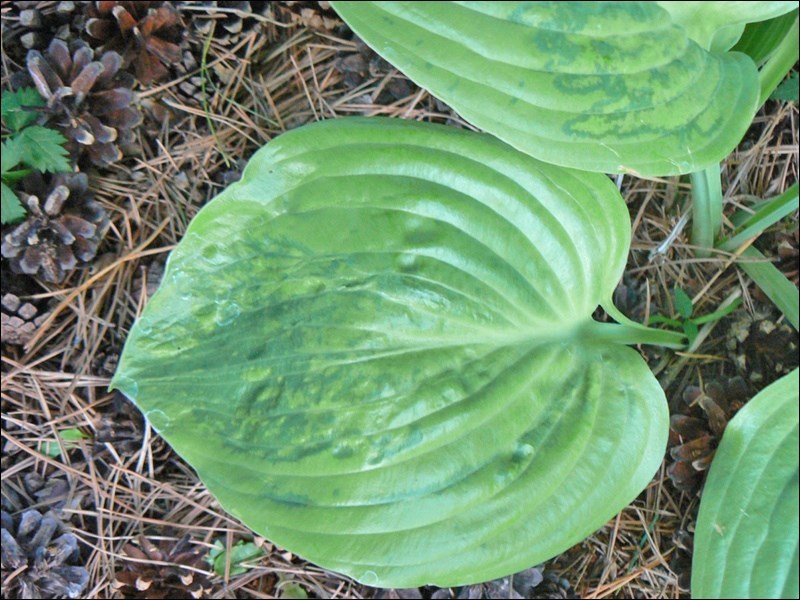Many prairie gardeners grow hostas. Not only are they attractive, coming in many shapes, colours and sizes, but they are ideal plants for a shady spot in the garden. As our gardens mature, and trees and shrubs use up more available sunlight and moisture, hostas are perfect for brightening up those increased shady areas.
Until about 20 years ago, the biggest problem for hostas was attack by slugs that also enjoy damp, shady spots. However, in the 1990s a disease was noted on some hostas, and in 1996 the pathogen was identified as Hosta Virus X. A virus is a small particle of DNA or RNA (genetic material), wrapped in a protein coat that can be introduced into the cells of a plant with devastating results. The cells of the hosta become damaged, resulting in changes in how they function, which in turn affects how the plant looks. Typical symptoms include changes in the colouration of the leaves – blue and green leaf hostas may develop yellow and/or white markings. There may also be changes in leaf texture, with leaves that are twisted, puckered or lumpy.
These symptoms were initially thought to be interesting variations. Unfortunately, if you are not familiar with how your hostas should look, mild symptoms can be difficult to recognise. Hostas come in many colours (blue, green, yellow and white) and healthy plants often have variegated leaves, with patches of yellow and white on different parts of the leaf.
It is only as the disease progresses over several years and leaves begin to show severe puckering and patches of dead cells that you realize something is seriously wrong with your plant. This is particularly true with new plants, ones you are less familiar with. The disease has been spread by bringing in diseased plants that are initially only mildly affected. Some of the wholesale nurseries in Holland and the United States were found to have the virus in their growing fields, and this is likely where the disease originated.
When you find infected plants in your garden, there is no cure except removal of the plant. You must carefully dig out and bag all the infected plant material, making sure to remove infected roots as well. Do not replant another hosta into this space until all the roots have rotted away; probably three to four years to be on the safe side.
The virus is transmitted mainly by cutting diseased plants and allowing contact of the infected plant’s sap with sap of a healthy plant. This can happen when dividing hostas, removing bloom scapes (the flowering stems), removing leaves, stepping on them, even accidentally running the lawnmower over them. Wash your hands thoroughly and disinfect all your tools with a bleach solution after handling diseased plants.
One of the best ways to avoid this disease is to buy hostas only from companies that specialize in selling plants (greenhouses, nurseries and seed suppliers). Examine new plants carefully, and if even only one plant shows abnormal markings, it is best not to buy any from that batch. The hostalibrary.org listed a number of the varieties that were commonly infected in 2007.
Friends with established, healthy hostas are usually happy to share roots when they are dividing their plants. The Saskatchewan Perennial Society Plant Exchanges, held in May and September, are an excellent place to acquire divided hostas that have been split from healthy, established plants. Plant them in a suitable spot, in a hole with well-worked soil amended with compost, and water them in well. Keep them moist for several weeks, but do not over water. They should become established quickly.
If you would like to read more about Hosta Virus X, and shade plants in general, there are many excellent articles in the 2018 edition of The Prairie Garden.
[Jill Thomson is a plant disease specialist (retired) who enjoys gardening in Saskatoon with her family, including the dogs.]
— This column is provided courtesy of the Saskatchewan Perennial Society (SPS; [email protected]). Check our website (www.saskperennial.ca) or Facebook page (www.facebook.com/saskperennial) for a list of upcoming gardening events: Lots of gardening classes in April/May at the U of S.




